Do you even lift, bro? If not, then you’re seriously missing out. Lifting weights has a ton of benefits, from weight loss and muscle gains to greater strength and improved stamina. But how the heck do you go from zero weight room experience to full-on weightlifter?
If you’re ready to get those sweet lifting #gains, we’ve got tips from a pro to help you get started.
Quick tips to start lifting weights
- Consider going to a gym or consulting a personal trainer.
- Invest in basic equipment to get your lift on at home.
- Make sure you warm up before you lift AND cool down after each sesh.
- Start with lighter weights and increase weight gradually.
- Perfect your form before you start.
- Rest for at least 1 minute between sets and limit workouts to 45 minutes, tops.
- Take 2 or 3 rest days each week (recovery is key!).
- Build a customized workout plan that meets all your needs and #goals.
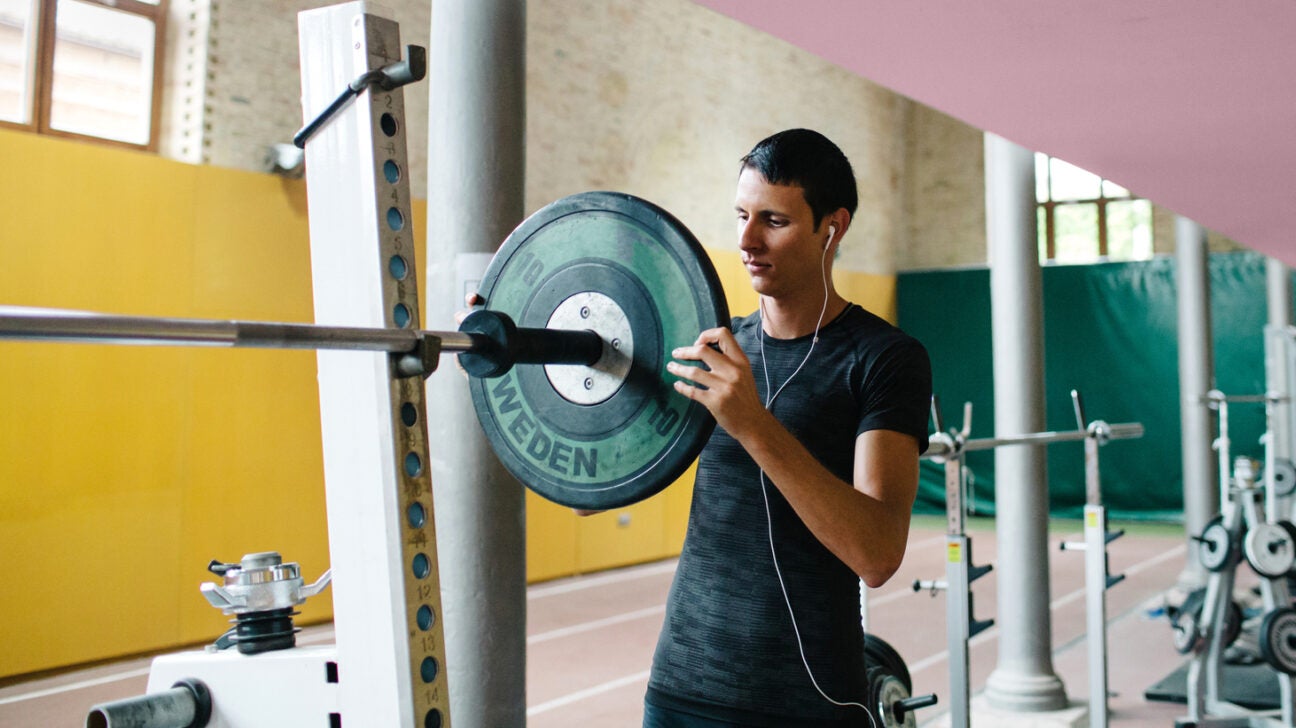
Let’s get into it: How to start weight training
Consult a trainer or join a gym
While you totally don’t need a gym or a trainer to start lifting dumbbells in your living room, starting your journey with guidance from a personal trainer can help you get a great foundation to avoid injury.
“Newcomers should always be shown professionally how to squat, deadlift, or even lunge properly,” says Ben Walker, personal trainer and owner of Anywhere Fitness in Dublin, Ireland. “This is so they don’t compensate their lower spine and damage vertebrae while performing an exercise.”
In addition to teaching you proper form, a personal trainer can work with you on specific exercises to help you reach your fitness goals.
Not sure how to connect with a pro? Your local gym is a great place to start. Most gyms have trainers on hand who can provide guidance on using machines and lifting free weights. They can also answer any questions you have to make sure you’re getting the most out of each sweat sesh.
Another option is to search online for local trainers who take private clients for one-on-one or small-group training. Some even offer virtual appointments, so you can get your lift on right in the comfort of your home (no commute necessary!).
Buy some weights
There are many exercises you can do with your own body weight. But if you’re ready to add some weightlifting staples to your home gym (or to start using them at the gym), you can consider:
To keep things simple, all you really need to get started is one set of dumbbells. Once you get more comfortable with the foundational moves, you can start adding weightlifting gear, kettlebells, and barbells to the mix.
Beginner tips to start strength training
Start with light weights and high reps
OK, but how much weight should you lift if you’re a beginner?
Walker recommends using lighter weights and doing more repetitions (the number of times you complete the movement) when you’re starting out.
What’s considered “light” depends on your current fitness level and what moves you’ll be doing. Different exercises can require different weight levels to be effective, based on which muscles they’re targeting and how many reps you plan on doing.
When selecting the appropriate weight level, you want to be challenged — without sacrificing proper form. If your weights are weighing you down so that your spine isn’t aligned and your back isn’t supported, you could be risking injury.
When in doubt, start out light.
Make sure you warm up
It’s important to warm up properly before jumping into any exercise. A quick warmup is necessary to prepare your muscles and joints for the workout ahead so that they’re limber and less susceptible to injury.
Warming up also helps increase blood flow to your working muscles and gradually increases your body temperature in preparation for harder work.
There are many ways you can warm up before you work out, such as:
- Stretching. Performing a series of dynamic stretches helps loosen your limbs, gets your blood a-pumpin’, and activates your muscles for peak performance, so your body is ready to hit the weights.
- Light exercise. Exercises like bodyweight squats can double as a warmup before you add weights.
- Light cardio. Cycling, walking, or rowing for just a few minutes can help prepare your bod for weightlifting.
- Foam rolling. Try adding foam rolling to your stretching routine. Regularly using a foam roller may help reduce muscle soreness and increase flexibility and range of motion.
- Using a massage gun. Sure, massage guns are great for relieving sore muscles, but research shows that they’re also beneficial for getting your muscles ready and raring to go before a workout.
Check your form!
Proper form is essential for workout success.
“Beginners should always be aware that keeping a ‘neutral spine’ is necessary at all times during every exercise. This is when our spine is situated in a straight position [with the natural curve], whether we are standing or positioned on the floor,” explains Walker.
A personal trainer can help make sure your form is in top shape!
Professional help not in the cards… or in your budget? We feel ya. Thankfully, there are many online resources (*cough, cough* Greatist 👀) to show you examples of what good form looks like and explain how to do it right.
Rest between sets
It’s important to give your muscles a little time off after completing a set.
When you’re a weightlifting newbie, aim for at least 1 minute of rest between sets (aka groups of reps). This’ll give your muscles time to recover and avoid getting overworked or fatigued.
These brief rest periods also give you the opportunity to grab a swig of sweet H2O and check in with your body. (Any pain points? Stiffness? Something feeling out of sorts? Use this time to take notice!)
Keep workouts to 45 minutes
All good things must come to an end — including a killer sweat sesh.
Limiting your workouts to 45 minutes can help you avoid overdoing it. Overtraining can leave you feeling tired, sore, and potentially cranky. It can also increase your risk of injury because you’re not allowing your muscles to properly recover.
Plus, there’s no science that says a longer workout produces better results. How you spend your time is more important than how much time you spend lifting, so use your minutes wisely and reap the benefits. And again, REST between sessions!
Increase weight gradually
As you get deeper into your weight training journey, you’ll find that your weights provide less resistance over time. This means your muscles are getting stronger! Yay!
It also means you can start to increase the amount of weight you’re lifting. But instead of tacking on a ton of extra poundage at once, introduce more weight little by little.
Gradually increase weight by 5 to 10 percent, making sure you’re perfecting each move (with proper form!) before increasing your weight levels again.
Cool down after you work out
A quick stretch sesh to cool down after a workout can help ease any muscle tension or tightness after lifting, as well as improve your flexibility and range of motion, according to a 2012 research review.
The research results on this are inconclusive and mixed, but it’s possible that stretching may also help prevent injury.
Plus, stretching just feels ah-mazing after you’ve hit the weights. You can also cool down with easy cardio, massage, or foam rolling. And don’t forget to rehydrate and refuel!
Make a workout schedule
Setting a schedule can help you stay consistent in your routine. Determine how and when to target certain muscle groups, and build in the right amount of rest and recovery for primo performance.
After a long day, a glass of wine and a Netflix marathon may sound better than a workout. So planning your workouts also provides you with some accountability — especially if you’re working out alone and don’t have a trainer or friend to hold you to it.
Your Netflix sesh will still be waiting for you after your workout.
Take rest days!
Rest days are a key component of any workout sched and are essential for promoting muscle recovery and reducing the risk of getting hurt.
When starting a weightlifting program, Walker recommends taking at least 2 or 3 rest days each week. “Each muscle group needs 48 to 72 hours to recover before performing the next workout. This is why it’s a good idea to do split workouts in the beginning.”
Split training involves focusing on specific muscle groups one day and then targeting others the next. This allows particular muscle groups to recover while you work out other groups.
“Once your body has adapted after a few weeks, the muscle groups will need 24 to 48 hours to recover,” notes Walker. “Recovering sooner, you can now plan your workouts more accordingly during the week and add an extra training day.”
Beginner weightlifting exercises to get you started
Here’s a quick refresher on weightlifting lingo:
- Reps (aka repetitions) = how many times you complete an exercise movement
- Sets = how many reps you do (for example, 20 reps may equal 1 set)
When you’re just starting out, Walker suggests performing an average of 3–4 sets of 20 reps each. As your muscles adapt to certain movements, you can increase the number of reps and sets you do during your workouts.
Got your dumbbells ready? Here are some of the best beginner weight training moves to get you started.
Dumbbell single-arm row

- Rest your left knee on a bench, keeping right foot planted on the floor. For balance, let your left hand rest palm-down near the front of the bench.
- With right hand, reach down and pick up your dumbbell. Make sure your back is parallel to the floor.
- Slowly lift the weight up toward your waist, bending elbow and squeezing shoulder and back muscles.
- Slowly lower the weight, extending your arm to return to the starting position.
- Complete 1 set, then switch to the other side and repeat.
Dumbbell shoulder press

- Stand with your feet shoulder-width apart, holding a dumbbell in each hand. (You can also do this one seated — just be sure to sit up straight so that your spine is aligned!)
- Lift your elbows so they’re raised at your sides at 90-degree angles.
- Turn your palms forward.
- Slowly press the dumbbells up toward the sky, straightening your arms. Make sure to keep your spine aligned — no leaning or arching your back!
- Slowly bring your arms back down to the starting position.
Shoulder lateral raise
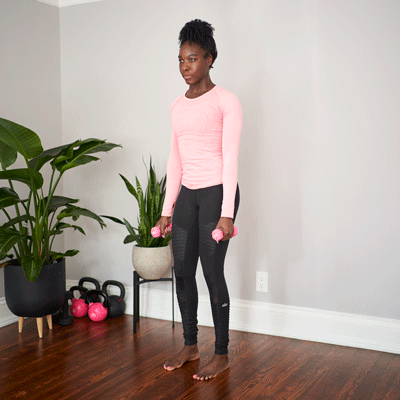
- Stand (or sit!) up straight with your arms at your sides and a dumbbell in each hand.
- Keeping your arms straight, slowly lift arms out to the sides until they’re parallel to the floor. Don’t pinch your neck or swing your arms. Use shoulder and back muscles to make this a slow, controlled movement.
- Slowly lower your arms back down to your sides.
Dumbbell chest press
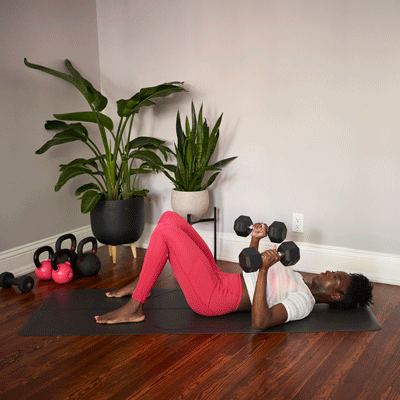
- Lie faceup on a bench or the floor, holding a dumbbell in each hand. Bend elbows at 90 degrees and position your arms at about a 45-degree angle to your body.
- With palms facing toward feet, slowly press the weights toward the sky, extending arms directly above your shoulders. Be sure to keep your elbows soft — don’t lock them!
- Slowly lower the weights back to the starting position.
Biceps curl
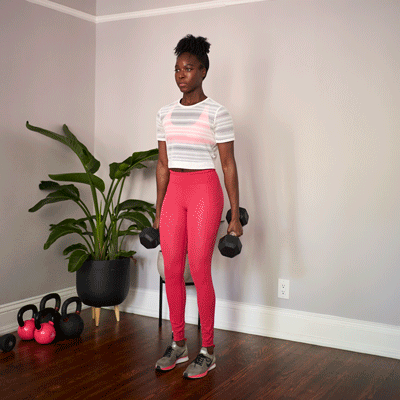
- Stand or sit with arms at your sides, holding a weight in each hand.
- Bend elbows to curl the weights up toward your shoulders, turning palms to face your body.
- Slowly lower the weights back to the starting position.
Triceps extension
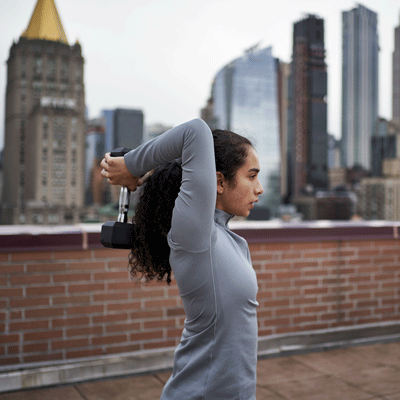
- Stand or sit, making sure your feet are shoulder-width apart.
- Hold a dumbbell vertically, with both hands around the handle.
- Lift arms straight up, so the weight is directly over your head.
- Don’t pinch your shoulders, and leave space between your elbows and ears. Slowly bend arms, lowering the dumbbell behind your head.
- Press the dumbbell up to the sky to return to the starting position.
Dumbbell lunge

- Stand with your arms at your sides, holding a dumbbell in each hand.
- Step forward with right leg, bending at the knee until right thigh is parallel with the floor (make sure your bent knee does not extend past your toes!). Let left leg bend to keep you balanced.
- Step right foot back to the starting position.
- Repeat with the other leg.
Weighted squat
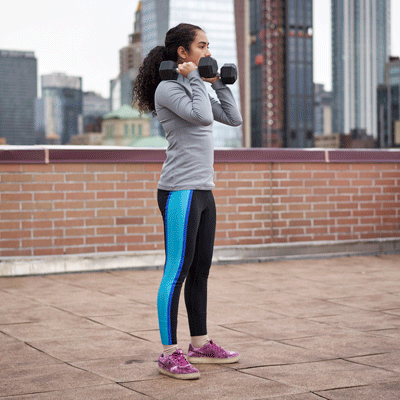
- Stand with feet shoulder-width apart. For weight, you can hold 2 dumbbells on your shoulders, 1 dumbbell at your chest, or a kettlebell at your chest (your choice!).
- Keeping the weight steady, slowly bend your knees and sit back into a squat, as if sitting in a chair. (Make sure your heels don’t lift off the floor.)
- Slowly rise back up to standing by activating your core and glutes.
Weighted calf raise
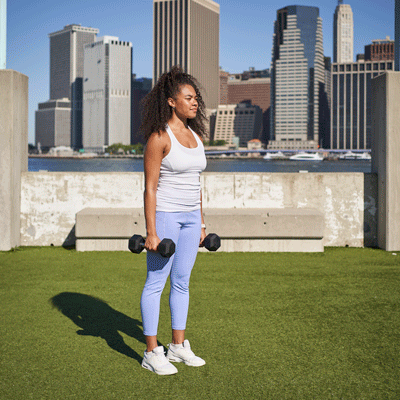
- Stand on a flat surface with feet shoulder-width apart and arms at your sides, holding a dumbbell in each hand.
- Slowly lift onto your toes, raising your heels off the floor.
- Hold for 1–2 seconds.
- Slowly lower your heels back down.
Your strength training schedule
Setting a weekly weight training schedule gives you a road map for which muscles to work when and allows for proper rest and recovery.
How many days you exercise each week really depends on your goals. But the American College of Sports Medicine generally recommends resistance training (i.e., weightlifting) 2 or 3 days a week for best results.
Here’s a simple 3-day plan (using the exercises above!) to help you get started:
| Day | Muscle groups | Exercises (3 or 4 sets of 20 reps) |
| Monday | upper body (shoulders, biceps, and back) | biceps curl dumbbell single-arm row dumbbell shoulder press |
| Tuesday | rest or cardio | |
| Wednesday | lower body (legs and butt) | dumbbell lunge weighted squat weighted calf raise |
| Thursday | rest or cardio | |
| Friday | upper body (triceps, shoulders, and chest) | shoulder lateral raise dumbbell chest press triceps extension |
| Saturday | rest or cardio | |
| Sunday | rest or cardio |
Start with the lightest weights possible, gradually increasing over time. This will help you achieve hypertrophy, which, Walker explains, is “when the muscle fibers break down to their best ability, so they can repair and grow larger.” (In other words: #gains.)
Pro tip: Walker says that getting enough protein and adequate sleep will also aid in muscle repair and help your muscles grow to their greatest potential.
How to start weight training safely
Whether you’re a newbie or a seasoned pro, it’s important to be careful when weight training. Exercising safely can help you avoid injury and ensure that you’re not burning yourself out.
Add these safety tips to your “must follow” list:
- Got pain? Seriously, if something hurts, stop and reevaluate. You may need to check in with a trainer about your form. If pain persists, consult a healthcare professional ASAP.
- Take it slow. Do each exercise slowly to reap the full benefits (and to steer clear of injuries!).
- Use proper form. Always make sure your form is top-notch when doing any weight lifting exercise.
- Hydrate, hydrate, hydrate! Rest periods between sets? Perfect time for water. Staying hydrated keeps your muscles and joints moving freely.
- Dress the part. Always wear the right gear for lifting. Workout clothes, closed-toed shoes, and weightlifting gloves can help make your workouts safe and effective.
- Breathe… just breathe. Pay attention to your breath as you move. Inhale before each lift and exhale during each lift.
- Always give your body recovery days. Skipping recovery days increases your risk of injury and can affect your fitness gains. Your body needs to recover to build muscle strength and size.
Takeaway
Weight training is a great way to burn calories, build muscle, and boost strength.
If you’re looking to add weightlifting to your workout routine, consider working with a trainer, setting a schedule, and investing in basic equipment (like dumbbells). To prevent injury or burnout, it’s important to start slowly, making sure you’re taking rest days and not doing too many reps or making your workout too long.
Always be safe when lifting weights. Take your time, use proper form, and never push through pain during workouts. If something feels wrong, stop your workout and consult a professional.

0 Commentaires